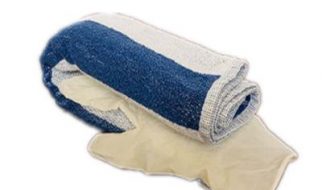
In our modern world, pollution in our environment is a huge concern, and rightfully so. Normally when we think of our environment, we think of our oceans, rivers, forests, and anything that is outside. However, we spend a large amount of our lives inside. Therefore, we should be concerned with pollution in our indoor environment as well. This is especially true for developing children, not just because they spend so much of their time indoors but because they are especially susceptible to toxins. Their bodies are so much smaller so even small amounts of toxins are more concentrated within their bodies. They are also still developing and growing. So, toxins can disrupt these processes.
Socioeconomic issues and environmental toxins are very important in our country today from a health standpoint. It is scary for me to think that a person?s future health and success in life can be so greatly influenced by conditions into which they are born, conditions that are beyond their control. Something as simple as the quality of the home and the neighborhood you live in as a newborn or child can drastically affect your development.
I wonder what I may have been exposed to as a child. I grew up in rural Arkansas. It was a very poor area. However, this would typically be a mostly unpolluted area; except that is was within two miles of two large chemical plants, one of which was coal-fired. I also, wonder about the safety of all of the building materials that were used in my childhood home, and the air quality of my neighborhood. Although, I feel like I turned out very healthy, I wonder what I was exposed to unknowingly.
One part of our homes and other indoor environments that concerns me, especially for children, is flooring. Children play and crawl on the floor and are in much closer proximity, more often than most other people. One must question if these surfaces are safe for children. Vinyl flooring is concerning because it is made up of processed material and contains chemicals.
So, what chemicals does vinyl flooring expose us to?
Vinyl flooring is manmade and contains PVC which releases many different phthalates, specifically DEHP (diethyelhexyl phthalate), a particularly troubling compound. DEHP can be found inside homes at the level of up to 3000 ppm in household dust and 18 ppb in household air. Children ingest up to ten times more of this contaminant than adults. The primary pathway for children is ingesting household dust orally. (Xu et al.) The National Resources Defense Council found that all homes contain DEHP contaminants and that average levels of the chemical exceed EPA regulations for contamination. Because the EPA has no regulations on dust, the scientists used regulations for soil contamination at hazardous waste sites, meaning the DEHP levels inside these homes were higher than those at toxic waste sites! (Singla) This was shocking to me! The Material Safety and Data Sheet on this chemical, however, said that it was not a carcinogen and had no developmental effects. However, it did state that it could be toxic to the liver and the nervous system. It also stated that it was mutagenic to certain organisms, such as bacteria and yeast. If it is mutagenic to other organisms, especially those that can be found within our bodies like bacteria, we should be concerned with its effect on humans. Vinyl chloride, which makes up PVC found in vinyl flooring, is a known carcinogen and a volatile organic compound (VOC). (greenbuildingsupply) Interestingly, the Material Safety Data Sheets on all of the vinyl flooring I found say that it is either ?relatively? non-toxic except for in case of thermal decomposition or simply not toxic at all. They list no known hazardous effects.
Other chemicals such as dioxins, ethylene dichloride, and even mercury are also released by PVC. These chemicals are highly persistent and bio accumulative, meaning that once they are in our environment and, consequently, in our bodies, they remain there for an extremely long period of time. They can last for decades. Older vinyl flooring or some flooring products made in China have even been known to contain formaldehyde. The following video shows an investigative report done by 60 minutes into the formaldehyde levels in flooring sold at Lumber Liquidators. Lumber Liquidators claimed that this product was compliant with California regulations. However, when investigators went to the Chinese factories where the flooring was made, the workers admitted they were mislabeling these products.
And the following video shows an update to that report that showed an error in calculation. The levels of formaldehyde were actually 3.3 times higher than they originally calculated and 18 times higher than normal formaldehyde levels in a home.
This was not the first time that vinyl flooring has come under scrutiny in the media. In the 1970?s, working in a PVC factory became linked to a very rare type of liver cancer. The EPA and OSHA had to step in to set regulations for workers? exposure. In the 1980?s, asbestos was found in vinyl flooring. This is still a concern today when remodeling older homes. If you suspect the flooring may be 30+ years old, you should have an expert remove it. (Mother Earth News) In the 1990?s, controversy ignited over a study that suggested a link between PVC factory work and brain cancer. There is documented proof that the scientist who conducted the experiment was heavily pressured by PVC chemical companies. Ultimately, he recanted his original findings siting diagnostic bias. (Sass, et al.) Today, despite the controversy, vinyl flooring has had a surge in popularity. It has essentially been rebranded as ?Luxury Vinyl Flooring? and touts its new advancements and realistic look while maintaining its low price. (Mother Earth News)
Furthermore, these chemicals are not just dangerous in our indoor environments. Toxins are released into our outdoor environment during manufacturing and disposal. There is no safe way to dispose of this material and recycled material can contain chemicals that have been previously excluded from use because of harmful effects. This means that new products could contain previously banned chemicals if the material they recycled contained those chemicals. By-products created during manufacturing consists of chlorinated dioxins (polychlorinated dibenzo-p-dioxins), chlorinated furans (polychlorinated dibenzofurans), polychlorinated biphenyls (PCBs), hexachlorobenzene (HCB), and octachlorostyrene (OCS). These chemicals are released into our environment where we can be exposed to them. (Thornton)
So, what effects did the research find?
As with many chemical products, the research was conflicting. One issue that made conclusions difficult was that not all manmade flooring contains these harmful chemicals. Linoleum, for example, is made a natural linseed oil. However, it is hard to tell these types of flooring apart from one another without chemical testing. Many studies that test the safety of vinyl flooring were not able to distinguish these two flooring types and grouped them together when examining their harmful effects on case subjects. Therefore, the correlations to harmful diseases may not be a strong as they would have been if that separation had been made. Other experiments have looked specifically at the presence of the phthalate chemical compounds in the indoor environment to see how this effects children. Many of the results suggested that vinyl flooring was harmful to children, but others either found no effect or a positive effect on children?s health.
The studies that did find negative effects of phthalates in vinyl flooring on children focused primarily on their effect on the airways and assessing phthalate levels inside the body. Scientists found that phthalates were found in all homes, regardless of flooring type. However, phthalate metabolite levels in the urine samples were higher in homes with vinyl flooring. This suggests internalization of the chemicals from vinyl flooring. (Just, et al.) The same group of scientists found a strong correlation with airway inflammation and asthma. (Just, et al.) This association with asthma was confirmed by another experiment that tested DEHP specifically. The scientist also found links to dermatitis, rhinitis, and eczema with exposure to DEHP and the presence of vinyl flooring in the homes of the case subjects. (Tanaka, et al) (Kolarik, et al.)
Other findings, however, suggest no significant effect caused by phthalates or even an improvement to some of these airway inflammation symptoms. One study to assess how environmental controls can reduce allergens in children found a positive association with the use of cushioned vinyl tiles in children?s bedrooms. Among other stringent requirements, vinyl flooring was used in an attempt to reduce mite, cat, and dog allergens from the children?s bedrooms. The scientists found that this was effective in reducing the allergies of these children. They also found a reduction in asthma. These findings conflict with the earlier outcomes mentioned. It?s important to note that this study was completed only 15 years ago, after vinyl flooring came under scrutiny. (Simpson, et al.)
Another study exposed human subjects to air containing high and low levels of DEHP. They, then, assessed symptoms and measured their protein and DNA. The individuals experienced no significant difference in symptoms after being exposed to high levels of DEHP. There was a small difference detected only during exposure to low levels of DEHP. Therefore, there was very little evidence of negative effects on the subjects? airways. However, the scientists did find changes to the protein levels and genes in all of the subjects? DNA. (Deutschle, et al.) I found this very disturbing!
There is another emerging area of concern when it comes to phthalate exposure. A number of phthalates, including DEHP found in vinyl flooring, have been found to be endocrine disruptors. The endocrine system acts as a switch board for our hormones and initiates processes in our body, such as gender and reproductive developement. Endocrine disruptors can stop this switchboard from functioning properly. One important process that these endocrine disruptors affect is the development of the male reproductive system. It is said that there is a specific window of time during pregnancy in which the process of masculinization occurs. Otherwise, the default gender is female. Therefore, if this process is completely disrupted, a person who originally would have been male remains a female instead. Even if the process is just partially interrupted, a genetic male can be born with a whole host of mutations and deformities of his reproductive organs. (Witorsch et al.) This especially terrifying to me because I fear it could disrupt the balance of gender on a grand scale. If there are not enough males in our population, our population with decrease in size generation after generation. I worry it would be possible that phthalates in our environment would prevent masculinization completely and we would not be able to reproduce at all! This is an area of research that we should be very concerned about!
So, what should we do now?
So, while there seems to some conflicting studies and inconclusive proof of the harmful effects of vinyl flooring, there are mounting concerns. Further investigation is needed, such as the determining the activities that are causing the higher levels of phthalates in our bodies and the mechanism that causes the associated illnesses. I would also be interested in more research into the gas that the floors emit and residue that can be transferred through skin. Additionally, there needs to be more research on the effects of these chemicals on fetuses while they are still in vitro.
Luckily, if you are as concerned with the toxins in vinyl flooring as I am, there are easy steps you can take. The bad news is there are a wide variety of concerns when it comes to any flooring, however. You must worry about the material, the sealants, how it is installed, and how it holds allergens.
Hardwood is typically the best option, but can be expensive and hard to maintain. You must also be careful that it isn?t engineered and be cautious of the glues used during installation. This can contain chemicals. When possible, replace the glue for nails during installation. It is also important to use water-based sealants. Wood should not be used in moist places of your home because of rotting. These include the kitchen, bathroom, or laundry room. (Flooring)
Linoleum is another option that is made of biodegradable oils. It is just as affordable as vinyl and other manmade options but can last 10+ years longer. With this option, you must be cautious with the glue used in installation. There are tiles that interlock, thus avoiding the need for glue all together. (Flooring)
Ceramic, glass or porcelain tile is another great option. You just have to be sure you are using grout, sealants, adhesives and cement backer that are safe and nontoxic. (How to Find..)
Much like vinyl flooring, there seems to be a considerable debate as to whether carpet is a good option. The analysis discussed by Simpson (above), assessed that carpeting presented unfavorable allergen conditions that contributed to asthma. However, an experiment by the J&J flooring group determined that carpeting served to absorb particulates out of the air and proved to be a healthy choice. (Simpson)
Lastly, cork and bamboo are natural options. It?s important that they use non-toxic glues, however. There are many certification standards that rate the safety of these products. The Environmental Working Group suggests you buy products with a Green Seal 11 certification. (Flooring) This organization checks the health, environmental and social impacts of all of the products used for all of these flooring types, including materials, sealants, glue, etc. (Green Seal)
If you already have vinyl flooring in your home, regular dusting can reduce levels of phthalates from contaminating your air. (Deutschle, et al.) Making sure your children wash their hands before they eat or put them into their mouths is important as well. There are also air purifier specially designed to filter out phthalates and volatile organic compounds such as vinyl chloride.
Sources
Commercial Carpet Tile, LVT & Kinetex Flooring by J J Flooring Group. (n.d.). Retrieved June 26, 2018, from http://www.jjflooringgroup.com/
Deutschle T, Reiter R, Butte W, Heinzow B, Keck T, Riechelmann H. A Controlled Challenge Study on Di(2-ethylhexyl) Phthalate (DEHP) in House Dust and the Immune Response in Human Nasal Mucosa of Allergic Subjects. Retrieved June 18, 2018, from, https://ehp.niehs.nih.gov/11474/
Flooring. (n.d.). Retrieved July 1, 2018, from https://www.ewg.org/healthyhomeguide/flooring/#.Wzk0yzsdc_U
Green Seal Standards. Retrieved July 1, 2018, from http://www.greenseal.org/GreenBusiness/Standards.aspx?vid=ViewStandardDetail&cid=0&sid=6
Hirshberg, J. (n.d.). Why we don?t sell luxury vinyl tile ? Green Building Supply. Retrieved June 26, 2018, from https://www.greenbuildingsupply.com/Learning-Center/Flooring-LC/Why-we-dont-sell-luxury-vinyl-tile
Kolarik, B., Naydenov, K., L., Bornehag, C., & Sundell, J. (n.d.). The association between phthalates in dust and allergic diseases among Bulgarian children. Retrieved June 18, 2018, from http://europepmc.org/articles/PMC2199301
Ogden Publications, Inc. (n.d.). Is PVC Safe? The Vinyl Debate. Retrieved July 1, 2018, from https://www.motherearthnews.com/green-homes/the-vinyl-debate
Sass, J. B., Castleman, B., & Wallinga, D. (2005, July). Vinyl Chloride: A Case Study of Data Suppression and Misrepresentation. Retrieved July 1, 2018, from https://www.ncbi.nlm.nih.gov/pmc/articles/PMC1257639/
Singla, V. (2016, December 15). Toxic Dust: The Dangerous Chemical Brew in Every Home. Retrieved June 26, 2018, from https://www.nrdc.org/experts/veena-singla/toxic-dust-dangerous-chemical-brew-every-home
Simpson, A., Simpson, B., Custovic, A., Craven, M., & Woodcock, A. (2003, September 22). Stringent environmental control in pregnancy and early life: The long?term effects on mite, cat and dog allergen. Retrieved June 19, 2018, from http://onlinelibrary.wiley.com/doi/10.1046/j.1365-2745.2003.01679.x/full
Tanaka, M., Inoue, K., & Takano, H. (n.d.). In vivo immunoamplifying effects of di-(2-ethylhexyl ? Retrieved June 19, 2018, from https://www.ncbi.nlm.nih.gov/pmc/articles/PMC1247566/
Thornton, J. (n.d.). Environmental Impacts of Polyvinyl Chloride (PVC) Building ? Retrieved June 26, 2018, from mts.sustainableproducts.com
Just, A., Miller, R., & Whyatt, R. (n.d.). Vinyl flooring in the home is associated with children?s ? Retrieved June 19, 2018, from http://web.b.ebscohost.com.ezproxy.lib.utexas.edu/ehost/pdfviewer/pdfviewer?vid=3&sid=5ee40b2c-6d00-4ac1-86cd-a2c71d2377d0@sessionmgr103
Just, A. C., Whyatt, R. M., Miller, R. L., Rundle, A. G., Chen, Q., Calafat, A. M., . . . Perzanowski, M. S. (2012, November 01). Children?s Urinary Phthalate Metabolites and Fractional Exhaled Nitric Oxide in an Urban Cohort. Retrieved from https://www.ncbi.nlm.nih.gov/pmc/articles/PMC3530221/
How To Find Non-Toxic Flooring For Your Home . (2018, January 08). Retrieved June 19, 2018, from http://www.momscleanairforce.org/non-toxic-flooring/
Witorsch, R. J., & Thomas, J. A. (2010). Personal care products and endocrine disruption: A critical review of the literature. Critical Reviews in Toxicology,40(Sup3), 1?30. doi:10.3109/10408444.2010.515563
Xu, Y., Hubal, E. A., & Little, J. C. (2010, February). Predicting Residential Exposure to Phthalate Plasticizer Emitted from Vinyl Flooring: Sensitivity, Uncertainty, and Implications for Biomonitoring. Retrieved June 26, 2018, from https://www.ncbi.nlm.nih.gov/pmc/articles/PMC2831926/


